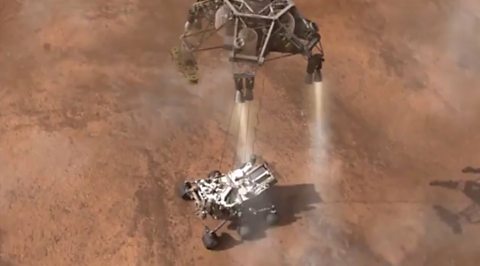TIM PEAKE:Hi, I'm Tim Peake. I'm an astronaut based here at the European Space Agency, in Germany. And from December 2015 to June 2016, I spent six months orbiting Earth on the International Space Station. What I'm in is an exact replica of the Columbus Science Laboratory, which is where I lived and worked when I was in space.
TIM PEAKE:Now the ISS is a satellite. One of around 4000 that are orbiting the Earth right now. The precise science behind how they get up there, and stay above the Earth over particular spots is fascinating.
TIM PEAKE:And here to explain it, with some facts about my old home thrown in too, is Dr Maggie Aderin-Pocock.
DR MAGGIE ADERIN-POCOCK:We're going to look at the breakthroughs that make this remarkable machine possible. What were the scientific challenges that were faced in the satellite revolution.
DR MAGGIE ADERIN-POCOCK:'And in the early days, there was one problem above all 'that space scientists wanted to solve. 'How do you get something, anything, to hover in space above the Earth.' Well a good place to answer that question is here by this lake. 'A beautiful spot to try and launch my own satellite.
DR MAGGIE ADERIN-POCOCK:'Three, two, one… 'Fire!
DR MAGGIE ADERIN-POCOCK:'The force of gravity has, of course, 'pulled my wannabe satellite back to Earth. 'What goes up always comes down.' Or does it? As we all know, the Earth is round. And that means as we travel over the surface, it gently curves away from us.
DR MAGGIE ADERIN-POCOCK:Now if you can travel fast enough, something miraculous happens. We keep on falling but we never hit the ground. Let's imagine that I can launch this orange at incredible speeds. 'It's something Sir Isaac Newton noticed 300 years ago.
DR MAGGIE ADERIN-POCOCK:'Relative to something moving horizontally, 'the curve of the Earth makes the ground beneath drop away. 'If my orange or anything else can move fast enough, 'it can stay ahead of that curve and effectively outrun gravity. 'It will never fall to Earth.'
DR MAGGIE ADERIN-POCOCK:Because the curvature of the Earth is quite slight, you need to be travelling at around 8000m/s to compensate for the pull of the Earth's gravity. If you can reach this speed, you're now travelling around the Earth rather than down towards it.
DR MAGGIE ADERIN-POCOCK:'Not easy of course when there is air resistance to slow you down, 'and obstacles to get in the way.' But once you get above the mountains and most of the atmosphere, let's say 300km up, you are now in space. And if you can keep your ball travelling fast enough it'll stay ahead of the curve.
DR MAGGIE ADERIN-POCOCK:You're in orbit. 'Well that's the theory. 'But it took 250 years after Newton's death 'before anyone built a machine powerful enough 'to put it into practice.
DR MAGGIE ADERIN-POCOCK:'In 1957, a Russian rocket carried the first man-made object 'into orbit above the Earth. 'No bigger than a beach ball, Sputnik stayed in orbit for three months. 'For the Soviet Union, it was a massive propaganda victory.
DR MAGGIE ADERIN-POCOCK:'On average two satellites pass over Britain every quarter of an hour. 'But they're not the easiest things to see.' Now what are you looking for? Well you're looking for something that looks a bit like an aeroplane, but it's not going to flash and it's going to move slowly across the sky.
DR MAGGIE ADERIN-POCOCK:'Tonight my team of Brownies is in for a treat. 'Because the biggest satellite of them all 'is due to pass directly over Hatfield. It's the International Space Station. 'The largest thing human beings have ever put into orbit.
DR MAGGIE ADERIN-POCOCK:'It took more than 12 years and 30 trips to build, 'and it circles the Earth nearly 16 times a day. 'Everyone including the astronomers with their telescopes 'is waiting for it to appear over the horizon.'
GIRL 1:Oh I can see a star moving really, really quickly.
DR MAGGIE ADERIN-POCOCK:Oh no see, I don't think that's a star moving that's the Space Station.
GIRL 2:I can see it!
DR MAGGIE ADERIN-POCOCK:That is the International Space Station. 'There's a crude rule of thumb… 'if a satellite orbits 300km up, 'It needs to be just one square metre for us to see it with the naked eye.
DR MAGGIE ADERIN-POCOCK:'The ISS has eight solar arrays, each 70m long. 'So with a pair of binoculars, 'you can see it from Earth in wonderful detail.'
GIRL 1What's that?
DR MAGGIE ADERIN-POCOCK:That's still the Space Station, so it's gone all the way from over there up above our heads and now it's heading over there. And you can see it's still moving slowly.
DR MAGGIE ADERIN-POCOCK:'Like many satellites, the ISS is only visible for a few minutes before it disappears over the horizon.' I think, yeah I think it's gone now. I know but at least we saw it!
DR MAGGIE ADERIN-POCOCK:'In the early days of satellites, 'this vanishing act was as frustrating to their engineers 'and controllers, as it was for our Brownies.'
DR MAGGIE ADERIN-POCOCK:It meant that the opportunity to transmit a signal, like a television picture, back to a particular point on Earth, was very brief. Maybe only lasting a few minutes.
DR MAGGIE ADERIN-POCOCK:So the dream of the first satellite engineers was to have a satellite that stayed stationary above a single point on the Earth. Allowing them to transmit information whenever they wanted.
DR MAGGIE ADERIN-POCOCK:So how do you keep an orbiting satellite hovering above a single point over a rotating planet? Well it seems simple, you just slow your satellite down until it's above the point you want.
DR MAGGIE ADERIN-POCOCK:But unfortunately it's a lot harder than it sounds and to show you, I'm going to use this carousel.
DR MAGGIE ADERIN-POCOCK:'Imagine it's the Earth spinning on its axis, 'and let's say I'm a satellite orbiting it. 'If I start slowing down to be above just one place, 'I'm not going fast enough to stay in orbit. 'So I start spiralling down towards the Earth.
DR MAGGIE ADERIN-POCOCK:'And eventually I burn up in the atmosphere.' There is a solution, the further I get away from the Earth, the weaker the effect of gravity. The less it pulls me back.
DR MAGGIE ADERIN-POCOCK:And there is a magical point where the force of gravity is so weak, that I can travel fast enough to stay in orbit, but also slowly enough to match the speed of a single point on the Earth's surface below.
DR MAGGIE ADERIN-POCOCK:'Scientists calculated that this is nearly 36,000km away. 'Orbit here and you can stay above the same point on Earth.' You are now in geostationary orbit. And when this was first achieved it triggered a revolution. Because now, any time day or night, you can beam information back to Earth.
DR MAGGIE ADERIN-POCOCK:This was the birth of the communication satellite. 'It meant that with as few as 3 geostationary satellites, 'you could beam a signal around the planet. 'Broadcasting it to almost anyone. 'The first satellite to relay a television signal was Telstar, 'in 1962.'
WALTER CRONKITE:Here we are, there's a bar, now… We're anticip-- That's a man's face. There it is! There it is!
DR MAGGIE ADERIN-POCOCK:'Its first broadcast lasted just 19 minutes. 'But within a few years, 'a network of geostationary satellites meant live communication 'was possible anytime, or any place, on Earth.'
WALTER CRONKITE:In the end when there are more satellites still, you'll have television and telephones all over the globe. A shattering thought.
TIM PEAKE:-So there you have it. Every time you watch a live telly event, be it sport, or a concert, or news report, those pictures have been beamed around the globe via satellites, travelling at 3,000 m/s. 36,000 km above us. Amazing.
Tim Peake introduces Maggie Aderin-Pocock who explains how satellites are launched into orbit around the Earth using an orange and a sling shot.
If the satellite is launched fast enough it never falls to Earth.
Above a speed of 8000m/s the surface of the Earth curves away just as fast as the satellite falls due to gravity pulling on it.
The satellite is in orbit.
The launch of the first satellite, Sputnik in 1957 is shown.
A group of Brownies try to spot the International Space Station as it passes over the UK.
A demonstration with a carrousel is used illustrate where and why a geostationary satellite is placed.
The first satellite to relay a television signal in 1962 is shown with an example of the first transmission.
Teacher Notes
Key Stage 4
Could be used to introduce satellites, including different orbits and their uses for monitoring the Earth or communications.
Students could investigate the history of launching satellites and the competition between USSR and USA in the late 20th century.
Students could research satellites that affect their lives eg ISS, Astra (satellite TV) or Inmarsat (satellite phone communications).
GCSE/Higher Levels
Could be used to start discussion on forces acting on a satellite in orbit and why they remain in orbit.
It provides an opportunity to consider the magnitude of the Earth’s gravitational field experienced by satellites.
There are plenty of opportunities to challenge students to calculate numbers for themselves.
For example: the speed a satellite needs to travel to remain in orbit at a height of 300km, the escape velocity required to launch a satellite into orbit and the speed and orbital radius of a geostationary satellite.
Curriculum Notes
This clip will be relevant for teaching Physics/Science at KS4/GCSE in England Wales and Northern Ireland.
Also National 4/National 5 and Higher in Scotland, and Cambridge IGCSE Physics.
More from the series Curriculum Collections: Physics
A scale model of the solar system. video
Dallas Campbell shows an orrery – a mechanical model of the solar system.
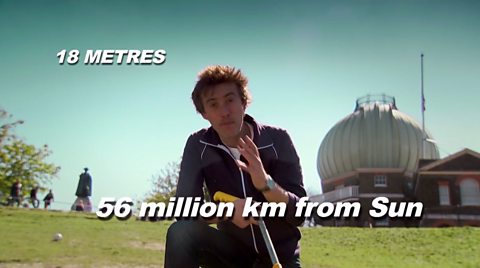
Centripetal force - explained. video
Tim Peake introduces Yan Wong who explains centripetal force using a cup of water on a tray hanging from a string.
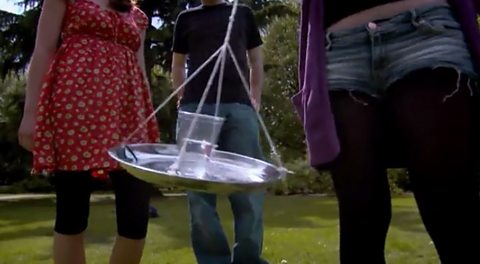
Days, Years and Seasons on Earth. video
Professor Brian Cox explains the seasons on Earth and the orbital periods of planets in the solar system.

How Halley’s Comet inspired Newton’s Law of Gravity. video
Simon Shaper explains how Newton’s Law of Gravitation originated from observations of Halley’s Comet in 1680.
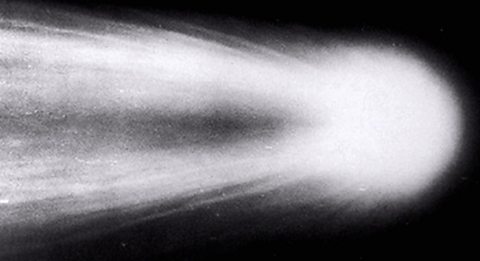
The Origin of the Northern and Southern Lights. video
Helen Czerski explains the origin of the Northern and Southern Lights.
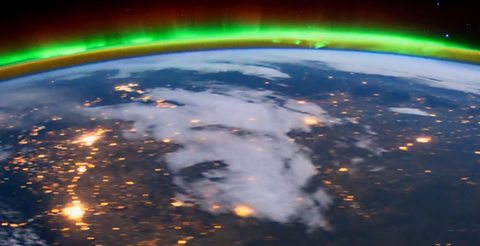
Landing a human on Mars. video
Tim Peake introduces the Physics behind sending a human mission to Mars.
